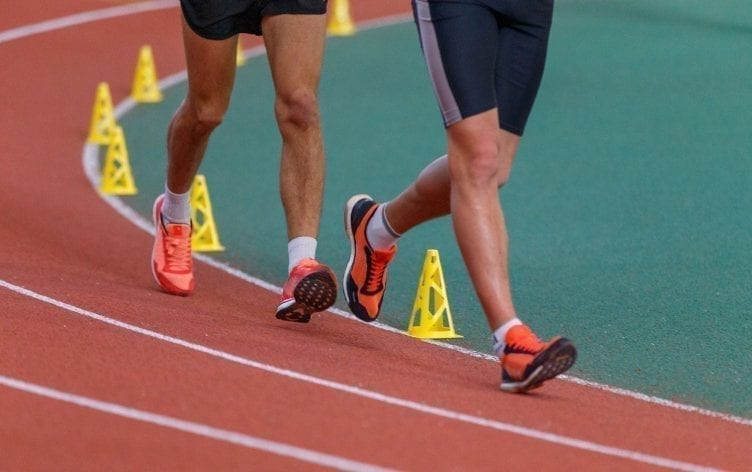
Race walking — the Olympic sport in which people actually walk a sub-six-minute mile — is a seriously compelling sport if you ever get a chance to watch it. It might sound slow, since walking isn’t typically considered an extreme sport, but make no mistake: Professional race walkers can walk faster than most recreational runners can complete a 5K.
If you’re hoping to lose weight by walking, or you’re trying to eventually transition to running from walking, emulating a race walker’s style and training is a great way to get faster and fitter. You may not want to race walk, but you can get speedier and more efficient with these tips.
MAKE YOUR BACK LEG DO THE WORK
“The key to walking, race walking, and even running fast is in the push off from your back foot,” says Katie Burnett, an eight-time American record-holding race walker. “Walking is great for toning your glutes down to your calves, but you have to make them work. Most people try to walk fast by reaching in front of them, but leaving your back leg down longer before pushing off is important to going fast.”
For a strong stride like this, hip mobility is critical, Barnett notes. “Race walkers use drills, strength training, stretching, foam rolling and more to stay on top of keeping good flexibility and strength to walk the paces they do,” she says. So get stretching!
FOCUS ON YOUR CORE
Barnett adds that getting a good push off of your back foot is tough unless you have a solid core to keep your body stable — remember, walking is a full-body activity, it’s not just our feet doing the work. “That push off with your back foot is hard to do unless you have working core muscles,” she says, adding, “Walking from the core helps give race walkers the look of gliding along the ground.”
To improve your core, consider adding a couple of minutes of core work to your warmup and cooldown routines. Movements, like walking lunges, are great for opening your hips, but they also do double duty as core exercises if you focus on maintaining a strong core. Think about tensing your abdominal muscles as you step. If you want more challenge, consider holding a plank pose (a high pushup) on the ground for anywhere from 10 seconds to a minute before and after each walk.
DO SOME (WALKING) SPEEDWORK
Most walkers think walking is done at a single pace, or every walk should be the same. We all fall into our natural walking pace, but if you’re hoping to speed up to start running, or you’re trying to lose weight by walking, sprinkling in some intervals is a great way to rev your metabolism and start getting used to a higher heart rate during cardio.
“Don’t do all of your walks at the same pace,” says Canadian professional race walker Rachel Seaman. “Try to throw in some pieces of a faster pace where you push yourself more than just a comfortable walk. Even if it’s just 30 seconds to a minute spent picking up the pace a few times throughout your walk, it’ll increase your heart rate and get your body into a different rhythm. As you get more comfortable doing those faster pickups, you can increase the amount of time you go faster.”
GET SERIOUS ABOUT YOUR WORKOUTS
Once you’ve gotten used to speedwork, where you casually pick up the pace a few times, you can start adding formal speedy walk workouts to your weekly routine. “Race walk workouts resemble running workouts,” says Barnett. “The only difference is that you race walk instead of run.”
“Tempos, intervals and long walks are common types of workouts,” she adds. “A fun one for any level of athlete is the 5/5/4/4/3/3/2/2/1/1 minutes. It’s a 30-minute workout, and the first time period is done at a harder pace and the second period at an easy pace. So you do five minutes at a sustained harder effort and then five minutes easy, then four minutes hard and four minutes easy, all the way down to one minute each. For more advanced athletes, you can repeat it — I’ve done it three times in a row, and the five-minute hard walking after the one-minute break can be difficult, but once you’re through it, you get a longer break and everything gets shorter after that!”
FOCUS ON YOUR ARMS
Seaman is all about efficient arm position. If you’re hoping to speed up your stride, bend your arms like a runner would: “A lot of walkers have their arms straight down by their sides but if you bring them to a 90-degree angle, you will have more power to move your body faster,” she explains. You might feel a little silly at first, but when you start to notice how efficient you’re getting, you’ll be glad you made the change. And if your eventual goal is to run rather than walk, getting in the (arm) swing of things is a good way to ease the transition.
POSTURE IS EVERYTHING
Regular walkers can learn a lot about good posture from race walkers. The focus on standing straight and tall can serve you not just during your walk, but in the rest of your everyday life as well — critically important if you spend all day hunched over the computer. “Race walking is really a full-body motion with the arms driving back to help with making your stride longer,” explains Barnett. “Think: Shoulders low and relaxed, upper body tall, and powering through your core.”
Make progress every day while you work on fitness and nutrition goals, like walking more steps. Go to “Plans” in the MyFitnessPal app for daily coaching and easy-to-follow tasks to keep you motivated.





